TR’s 10 Best Manga of 2014
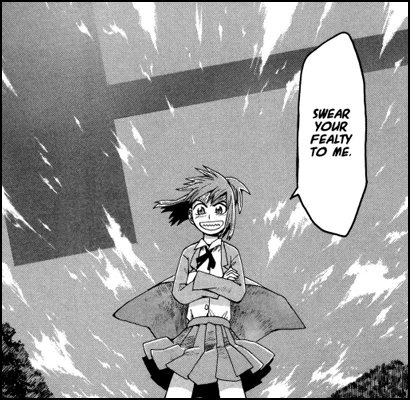 |
It’s that time again: time to struggle to pigeonhole a vibrant, diverse corner of the comics world into a neatly-arranged, 10-entry list. It’s been another pretty good year for manga in the west; global megahit Attack on Titan has done little but pick up momentum, gathering tie-ins, spinoffs, and an in-production movie, even as the manga itself has been teetering dangerously between stupidly awesome and awesomely stupid. Naruto came to a close in November, Yen Press has been feverishly adding light novels to their already robust selection of manga, and Seven Seas have a bizarre breakout hit in Monster Musume, which has topped the New York Times manga charts no less than six times in 2014. It’s a fun read, but it’s also a sex comedy that often stops just short of being actual porn, so it’s not quite right for this list. What is right for manga’s best of 2014? Try these on for size.
10) One Punch Man by ONE and Yusuke Murata
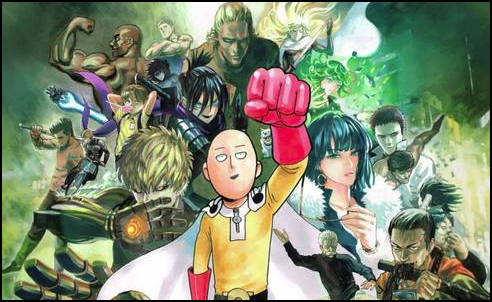 |
This exhilarating superhero spoof by ONE and Yusuke Murata topped last year’s list, and while I’m tempted to give the spotlight to a new crop this year, I’m obliged to lead off with the further adventures of Saitama, the most formidable (and boring, and nebbishy, and just plain weird) superhero in the world. Bad guys always underestimate him, leading him to live up to his title. His fellow heroes? You’d think they would love him, but they’re disgusted by his plain appearance and blunt language. Even worse, the apparent ease with which he dispatches monsters, aliens, and other rogues makes his fellow good guys look bad – a far greater sin than merely possessing great power!
One Punch Man is an expertly crafted spoof that always makes my Mondays brighter. His latest adversary is an absurd alien who keeps powering up, bringing to mind the old Tom & Jerry cartoon where they keep pulling bigger and bigger guns on each other. I’m gonna put on my shill hat and suggest that you subscribe to Shonen Jump if it’s available in your neck of the woods, both for this series and for another down the list- you can grab One Punch Man digitally, but the anthology version prunes out some of the series’ more ambitious, multi-page spreads. This is the one manga that I think every superhero comic fan should read. Don’t deny One Punch Man the opportunity to knock you out!
9) Say I Love You by Kanae Hazuki
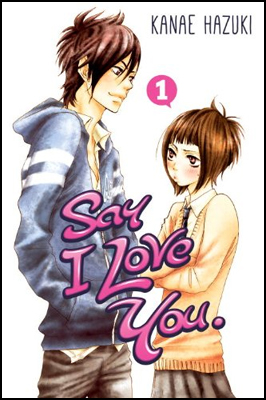 |
It’s been years since I’ve had a good shojo manga to sink my teeth into, possibly because I am not, in fact, a teen girl. But in spite of hewing to formula in some ways, Say I Love You has consistently brought me back to the table for more after finally beginning English publication in April. Kanae Hazuki’s character art is lovely, and the series’ heroine, Mei, is disarmingly self-possessed and honest. She’s also distrustful and frightfully anti-social, which complicates things when the handsomest, friendliest boy in school declares his affection for her, seemingly out of the blue.
It’s not quite that simple, of course; popular guy Yamato has had issues of his own – issues that lead him to seek out a partner who challenges him rather than settling for one from the flock of gossiping classmates following him down the hallways. Mei’s knocked down by his openness and affection; Yamato, for his part, finds her frankness attractive. In a storm of typical shoujo clich?s – Did he sleep with her?! Is she really going out with him? – it’s up to the pair to try and hammer out a relationship. We need comics like this, and we need comics like this to be great. Say I Love You is pretty great.
8) Master Keaton by Hokusei Katsushita, Takashi Nagasaki, and Naoki Urasawa
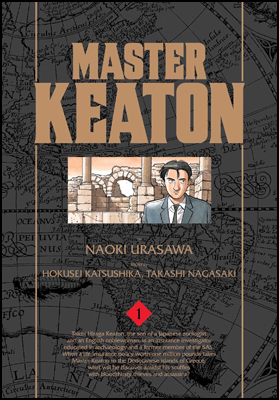 |
Here’s one of a few titles that crept onto this list late in the year, but its undeniable excellence means it deserves a spot. Naoki Urasawa has risen to prominence as the architect of some of the best manga ever made – riveting fare like Monster, 20th Century Boys and Pluto. Before all that, he teamed up with a pair of writers to give us Master Keaton, the thrilling adventures of an insurance adjuster.
Yeah, there are some twists and turns. Taichi Hiraga Keaton is a globe-trotter with a storied background- he studied at Oxford, is a proud veteran of the SAS (he served in the Falklands War before becoming a master sergeant), and spends the greater part of his time holding archaeology lectures at university. He’s also got a weird family life – he’s a divorcee with a young daughter, plus a complicated relationship with his gadfly father. Keaton isn’t a run of the mill insurance man, either – his post at Lloyd’s of London sees him dispatched to every corner of the earth to investigate the bizarre insurance claims of the rich, powerful, and secretive.
The resulting comic is a fantastic and engrossing adventure starring a hero who makes MacGyver seem a little roughshod and dim by comparison. Keaton’s a genuinely compelling character, and Urasawa’s bold, rich artwork is impossible to look away from. This new edition features some reworked, colored art that is beautiful and painterly, and each volume is jammed with more than 300 pages. If you’re cruising into your 30s or 40s and craning your neck, looking for well-traveled comic heroes to relate to, you could do a lot worse than Taichi Hiraga Keaton.
7) Lucifer and the Biscuit Hammer by Satoshi Mizukami
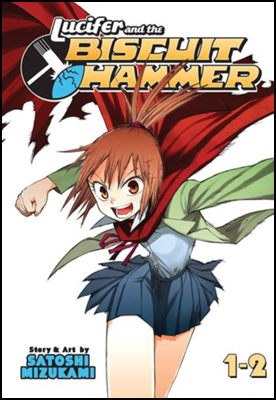 |
Yeah, that title is kind of a mouthful. And the premise – a devilish young girl and her knight protectors must defeat a mysterious, evil wizard who threatens the world with a giant, omnipresent, ominously floating mallet – is preposterous at best. But Satoshi Mizukami works some impressive magic in this series, grabbing up a bunch of stock clich?s – magical duels, a dour hard-luck hero, and gags involving panty flashes – and arranges them in an appealing new way.
I really appreciate two things about Lucifer and the Biscuit Hammer. One of them is its motley collection of heroes destined to save the world, which includes an assortment of mediocre students, unemployed washouts and hapless little kids. When the wizard (who isn’t exactly a man with a beard and pointy hat) emerges and you realize just how badly overmatched the heroes are, you really start to root for them and their talking animal familiars. (Did I mention they have talking animal familiars? The protagonist, Yuuhi, has a talking lizard!) The other thing I appreciate is the weird tension between Yuuhi, the aforementioned dour hero, and Asahina Samidare, the aforementioned “Lucifer,” a powerful magical princess. They’re kind of falling for each other and won’t talk about it, but they’re strongly united in their quest to save the world… so she can destroy it. Densely plotted and full of twists and turns, this is a series that can be enjoyed both digitally (via Crunchyroll Manga) and on paper, courtesy of Seven Seas’ elegant, double-wide translated volumes.
6) World Trigger by Daisuke Ashihara
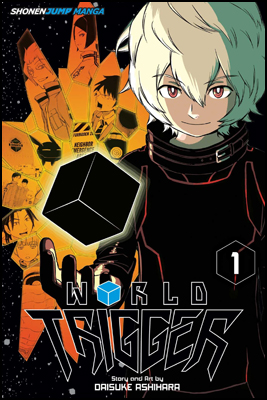 |
With the long-anticipated ending of Naruto, this series is the heir apparent to the big Shonen Jump crown (currently shared with perennial and seemingly never-ending favorites Bleach and One Piece). It’s about a city under siege from interdimensional invaders. A special agency, Border, fights the invaders, and the bespectacled Osamu Mikumo is one of the mightiest – okay, actually, he kind of sucks. But he is, indeed, part of the fighting force that protects Mikado City from the mysterious invading “Neighbors.” Then one day, a humanoid Neighbor arrives through the portal, wanting to settle into the city and go native.
The neighbor is Yuma Kuga, a much better fighter than Osamu, and as laconic and jolly as Osamu is uptight and serious, and that’s where the series strikes its balance. Serious, duty-minded Osamu wants to improve his skills and protect the city. Chilled-out Yuma wants to meet these Border folks he’s heard about and solve a mystery left behind by his departed father. At its heart a shonen fighting series, World Trigger is filled out with a variety of teammates and adversaries within Border, whose discrete departments squabble over Yuma’s fate and plan strategies against the Neighbor menace. This series was fun right from the beginning, but in the past year it’s really started to pick up momentum; much like Attack on Titan, it’s the kind of series where a new chapter is released in Monday’s Shonen Jump, and I read it so quickly it feels like it took seconds. Ignore the mediocre anime adaptation and keep your eyes fixed on this version.
5) Mobile Suit Gundam: The Origin by Yoshikazu Yasuhiko
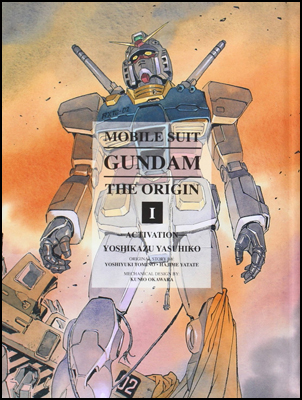 |
This one just missed the cutoff last year. Yoshikazu “YAS” Yasuhiko’s evocative spin on the “real robot” classic humanizes what was, at the root of things, a 43-episode advertisement for toys and model kits. Gundam: The Origin functions sort of like a “Year One” redux for the original Mobile Suit Gundam, with YAS, the cartoon’s original character designer, taking original creator Yoshiyuki Tomino’s broad strokes and adding layers and layers of detail. We still start with a dropped colony, a fierce war, a mixed-up kid and a scarily powerful prototype mobile suit, but YAS’s retelling gives us more background, more world-building, more moments of gripping drama, and more incredible shots of mobile suit combat.
The series launched in 2013; 2014’s volumes have largely been about the character of Char Aznable, the creation of the Principality of Zeon, and the stories behind fan-favorite characters like Ranba Ral. It’s really entertaining science fiction, and best of all, it doesn’t really require any prior knowledge of Gundam to enjoy it. Despite being an enduring classic of the medium, the original Gundam TV anime is weirdly absent from shelves and streaming services. But that’s okay; let Gundam: The Origin be your primer. Every one of these volumes is a hardcover, glossy, 400+ page beast. Spoil yourself with this release.
4) Assassination Classroom by Yusei Matsui
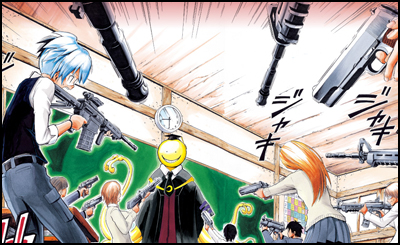 |
A schoolteacher walks into homeroom and greets his classmates, only the teacher is a grinning yellow octopus-man dressed up in a cartoonish-looking robe and mortarboard ensemble. His students respond by pulling out dozens of handguns, rifles, and machine guns and opening fire. The classroom explodes in chaos; at the end of it, there’s not a mark on the teacher.
Turns out the teacher is an incredibly powerful shapeshifting alien that moves at supersonic speeds. It has demonstrated its power by blowing a hole in the moon, and promises to destroy the world unless its students, a classroom of unruly borderline-dropout kids, manage to assassinate it, thereby winning themselves a massive cash reward. And thus you have Assassination Classroom‘s absurd, utterly hilarious premise. The resulting series is a sort of reverse GTO, as the delinquent, damaged, and otherwise terrible students rally together to try and kill their teacher.
The teacher, for its part, glibly encourages the kids with pronouncements like “You gotta learn the fundamentals of assassination!” There are elements of classroom comedy manga (the “beat this alien or the world is screwed” premise is itself lifted from Urusei Yatsura), a lampooning of Dragonball Z‘s barely comprehensible power levels, and bits that feel like Golgo 13 gone sideways. Assassination Classroom harkens back to comedy classics like Dr. Slump, the kind of manga where I can’t wait to turn the page and see what happens next.
3) Insufficient Direction by Moyoco Anno
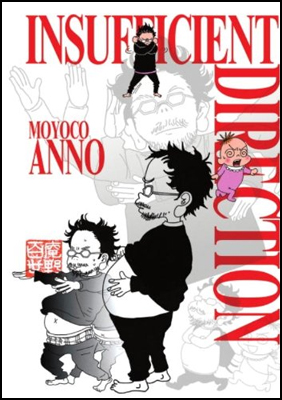 |
Do you strut around the house, quoting your favorite superheroes and imitating their dumb poses? Do you meticulously arrange the DVD and Blu-ray collection in your living room or den, so your nerd buddies will be suitably impressed when they visit? Do you sing along with anime songs in the car? Congratulations, this manga tells us, you’ve got something in common with Evangelion director Hideaki Anno.
Insufficient Direction is accomplished shoujo/josei manga artist Moyoco Anno’s affectionate tribute to her goofy husband and their “otaku marriage.” It’s a funny gag comic that depicts the great and mercurial Hideaki Anno as scruffy and somewhat portly, but still recognizable; meanwhile, Moyoco Anno, an attractive woman in real life, draws herself as a goggle-eyed toddler in footie pajamas. It’s just that kind of comic. The brief, gag-fueled stories concern such subjects as the couple’s halting attempts to lose weight, which Kamen Rider toys belong on display in the living room, and which social situations are best-suited for acting like Ultraman. There are copious comments, liner notes, and occasional greater details about the tribulations of the anime/manga business; both are occasionally depicted stumbling home from brutally long work sessions. As I’m a married dork with an amazing spouse who occasionally plays the role of “otaku wife,” Insufficient Direction really hits the mark. I hope every nerd marriage is as happy as the Annos’ one is.
2) A Silent Voice by Yoshitoki Oima
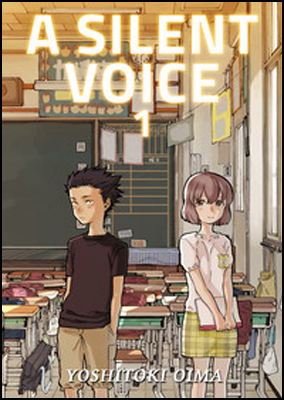 |
There’s plenty of manga out there with a lot to say about samurai, or ninja, or complicated romances, or transforming robots, or invading aliens, or some permutation of such. But how many manga take a serious and careful study of bullying and its effects? I’ve seen a few tackle the topic, but none with the thoroughness and thoughtfulness of A Silent Voice.
Young Shoya Ishida is a bully. He harasses other kids not out of malice, but simply out of boredom. One day there’s a new kid in class: a deaf girl named Shoko. Shoya starts teasing her immediately, and his classmates follow suit. But eventually, Shoko is too upset and unhappy with her classmates’ treatment and transfers out. The kids are restless and unhappy; they know they’ve done something wrong, but can’t admit it. So they target Shoya, and the former king bully becomes the scapegoat. For years. He sinks into a miasma of gloom and even contemplates suicide, but eventually comes up with a better idea: he’ll find Shoko and apologize to her.
A simpler story about bullying would end here. But the kind of teasing in A Silent Voice didn’t just harm Shoko and Shoya, it affected the entire class. The kids’ families have to deal with the effects. Even the teacher, who tries to keep his distance, plays a role in the bullying. It all builds up to the moment when Shoya, after years of sorrow and confusion, finds his old victim Shoko. He raises his hands to the shocked girl, and signs at her, and she. Just.
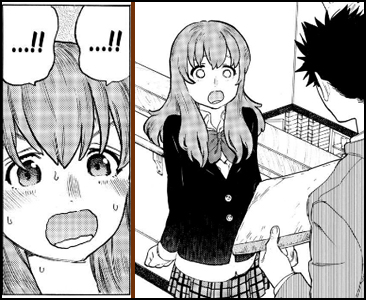 |
That’s not the end of the story, either- it’s the beginning. I’ll leave you with that. An anime version of A Silent Voice is in the works. In the meantime, fire up the Crunchyroll Manga app and get in on the ground floor.
1) Showa by Shigeru Mizuki
 |
“Oh great,” you’re thinking. “Once again, Toole piles the accolades on something old and weird that nobody’s ever heard of.” I know that One Piece is the manga that everyone loves, but people know about One Piece; you might not know about this title. In Japan, Shigeru Mizuki is a household name, the creator of the popular Gegege no Kitaro series. But he’s not just a popular manga artist – he’s a founder of the modern manga form on par with Tezuka and Ishinomori, and a goddamn national treasure. A few years back, Drawn & Quarterly released Onward Towards Our Noble Deaths, a set of stories about the brutality of the pacific theatre of World War II, drawn from Mizuki’s own experiences as a soldier. Showa is a radical expansion on that idea- a detailed, well-researched history of Japan in the 20th century, told through Mizuki’s eyes.
The resulting comic is dense and ingratiating. We meet Mizuki’s hardworking family, and discover he was kind of a dull child, dumbstruck by the rapid, chaotic changes that rolled over Japan in the 20s and 30s. Unlike more nationalist voices, Mizuki baldly depicts the savagery of Japan’s wartime activities. In these pages, we see the climax of World War II, after all has been lost, as the generals weep and beg the emperor to let them keep fighting. Showa is a history lesson, an autobiography, and a hard look at the human condition all rolled into one. Its fourth and final volume is due in the summer.
Since it came up last year, I’ll namecheck a few titles that just missed the cut. I’ve also greatly enjoyed Fumi Yoshinaga’s What Did You Eat Yesterday and Satsuki Yoshino’s Barakamon. I might’ve thrown Yuto Tsukuda and Shun Saeki’s Food Wars into the mix if there wasn’t already such a big representation of Shonen Jump titles in the lineup. I’m also greatly intrigued by Tetsuya Tsutsui’s Prophecy, but it’s really too early to tell just how good it is.
What have you enjoyed throughout 2014, readers? Lay it on me!
Previously by Mike Toole:
The 10 Best Things About the Dope New Batman ’66 Blu-ray Collection (Besides Its Mere Existence)
9 Interesting Ways Edge of Tomorrow/Live. Die. Repeat. Differs from its Source Material
Nine Surprising Ways the Original Oldboy Manga Differs from the Korean Film
